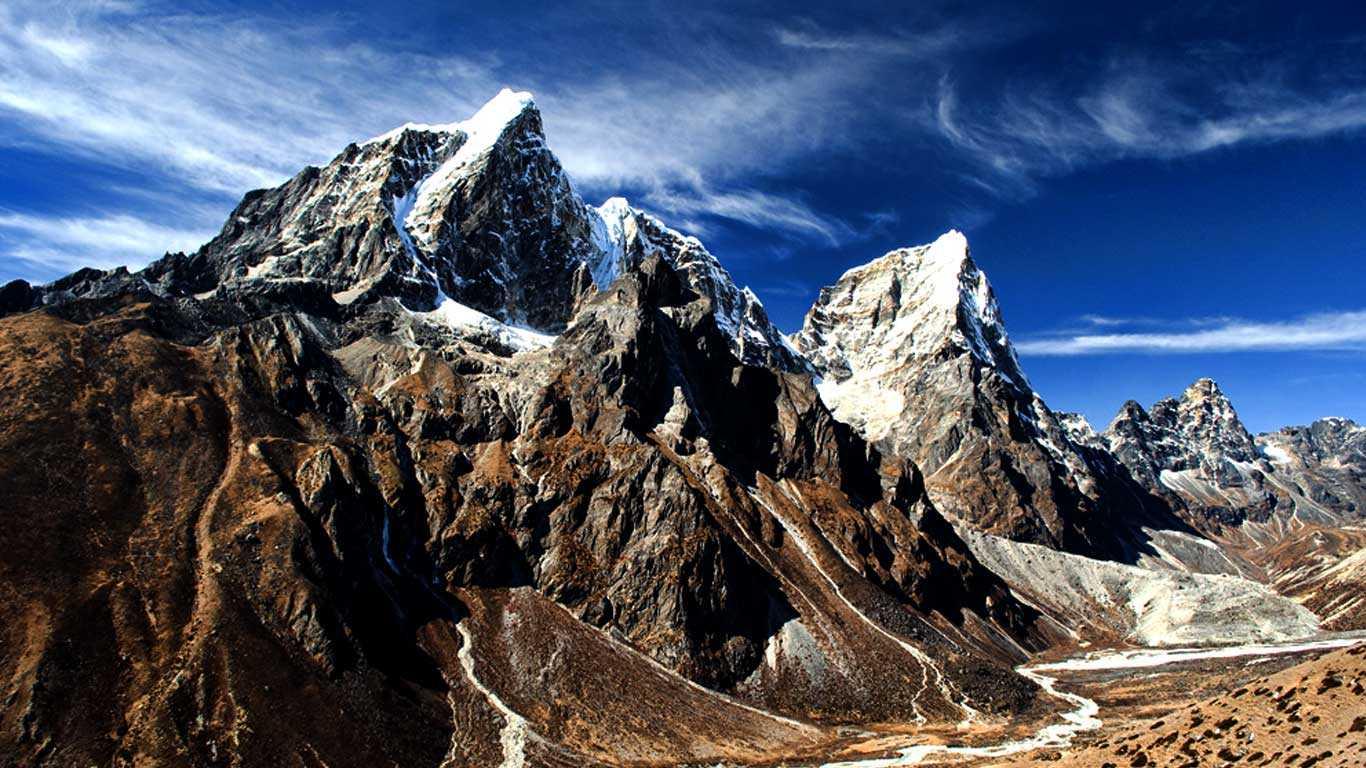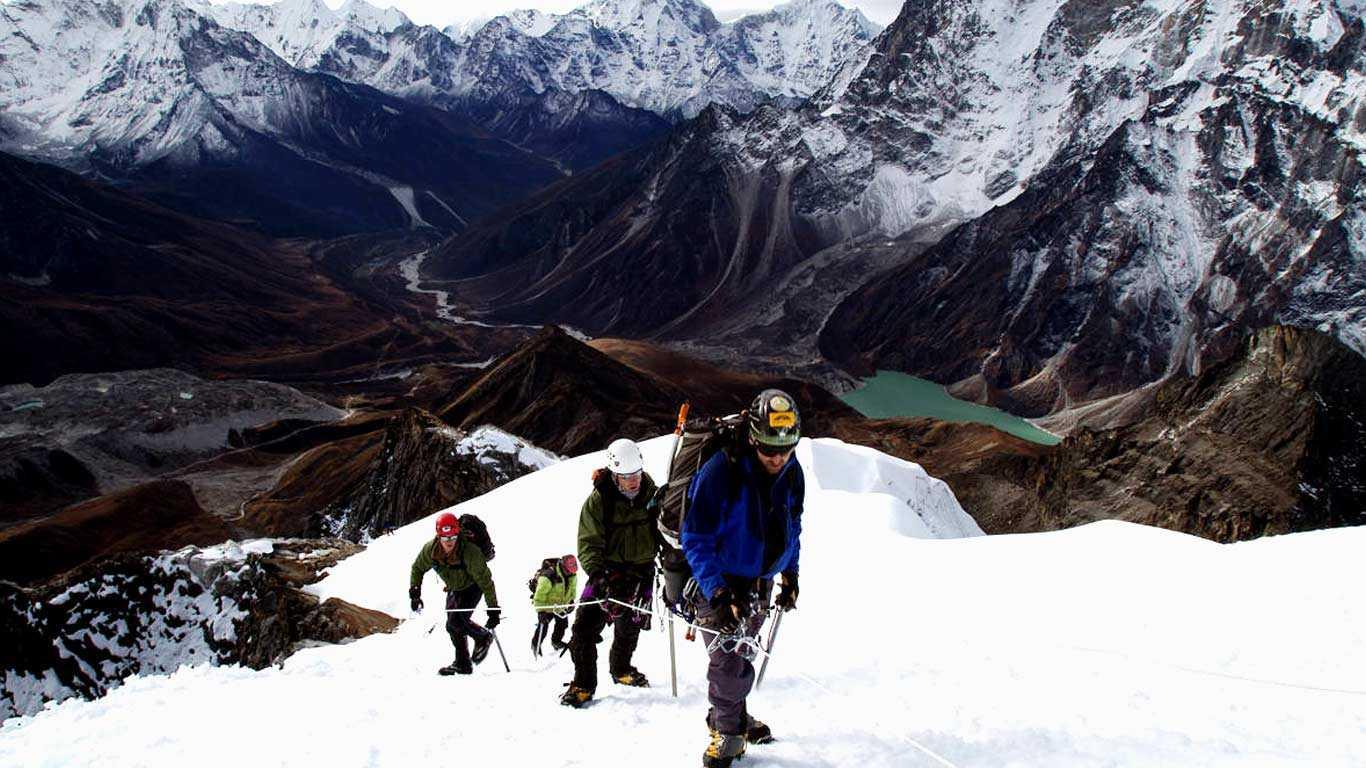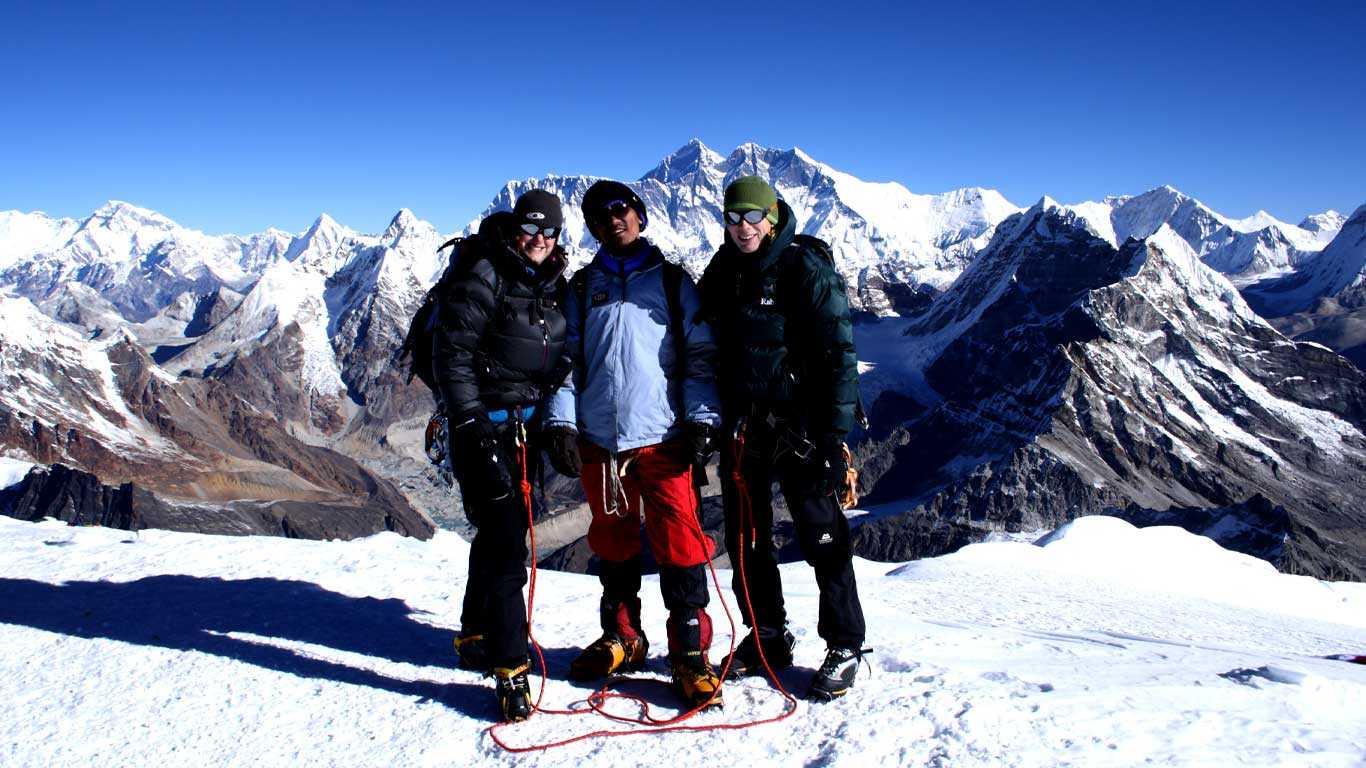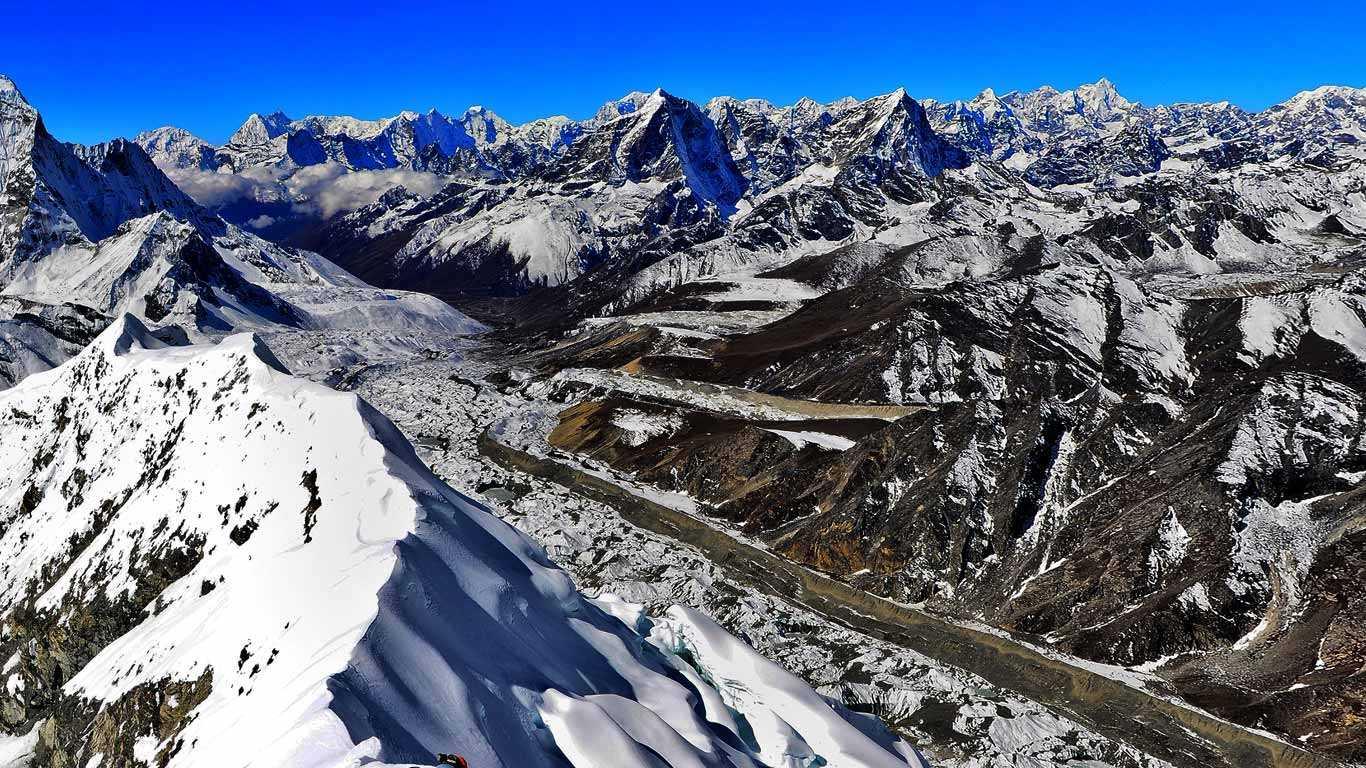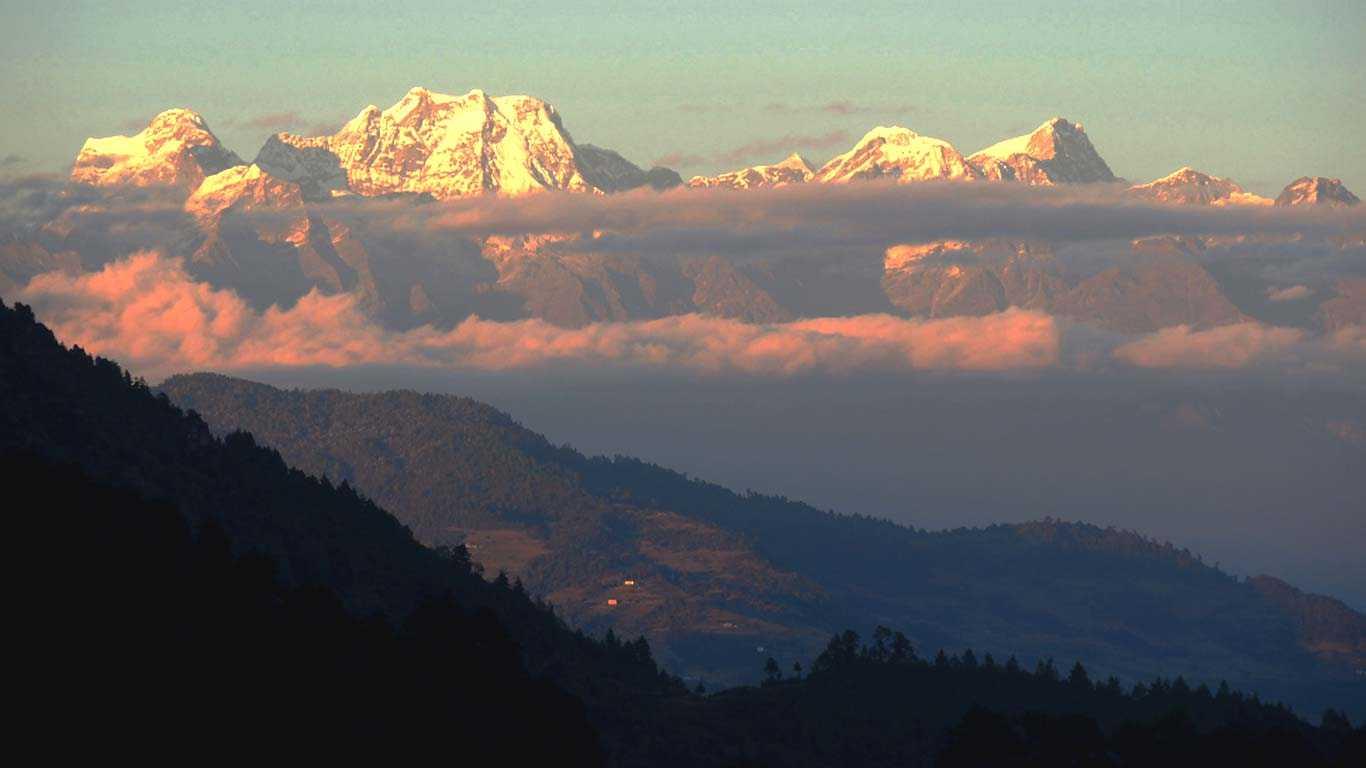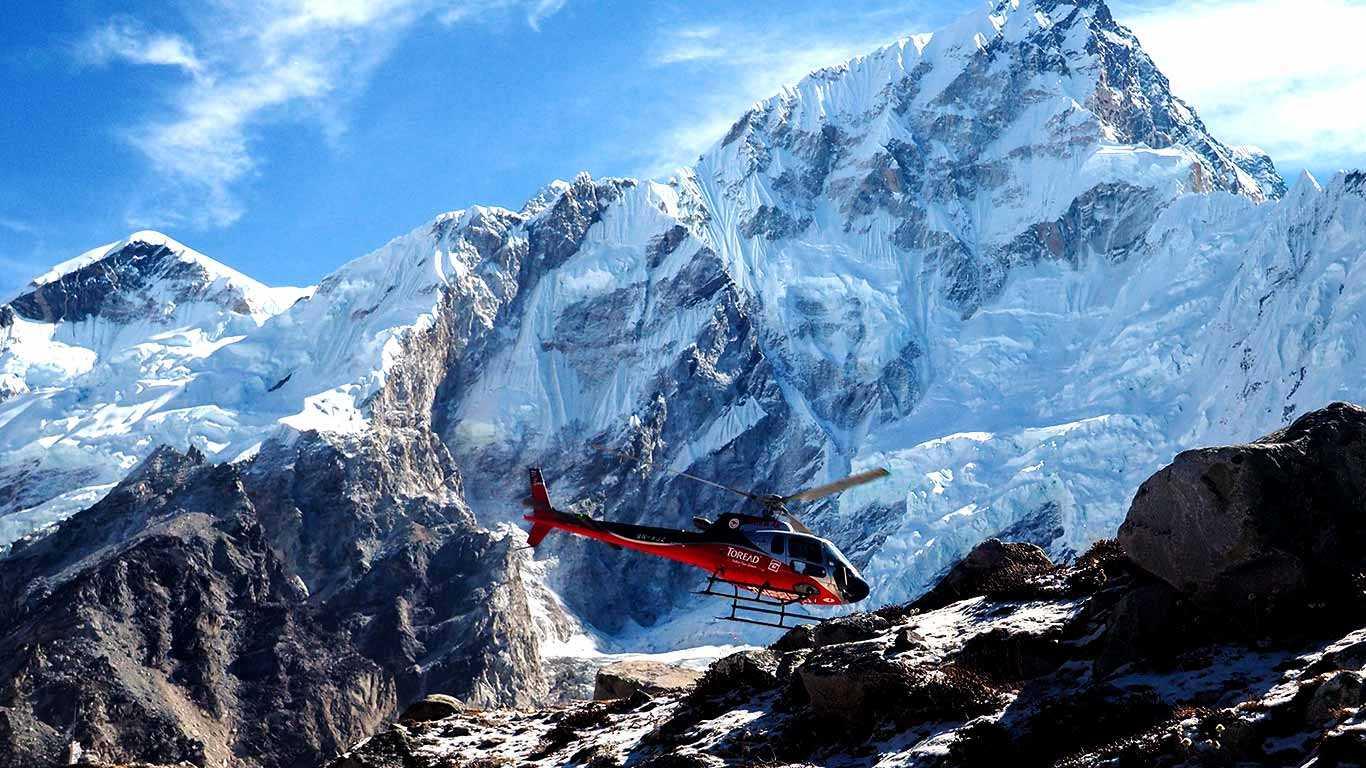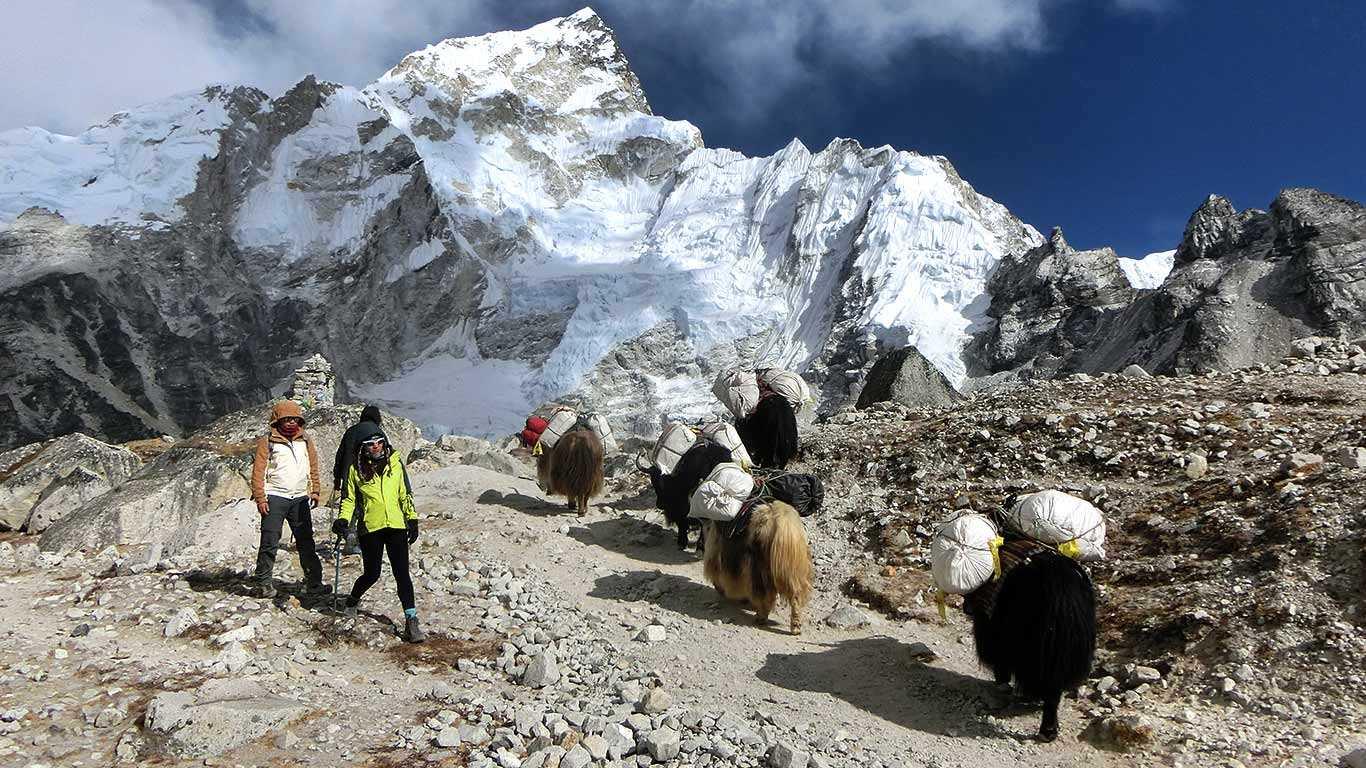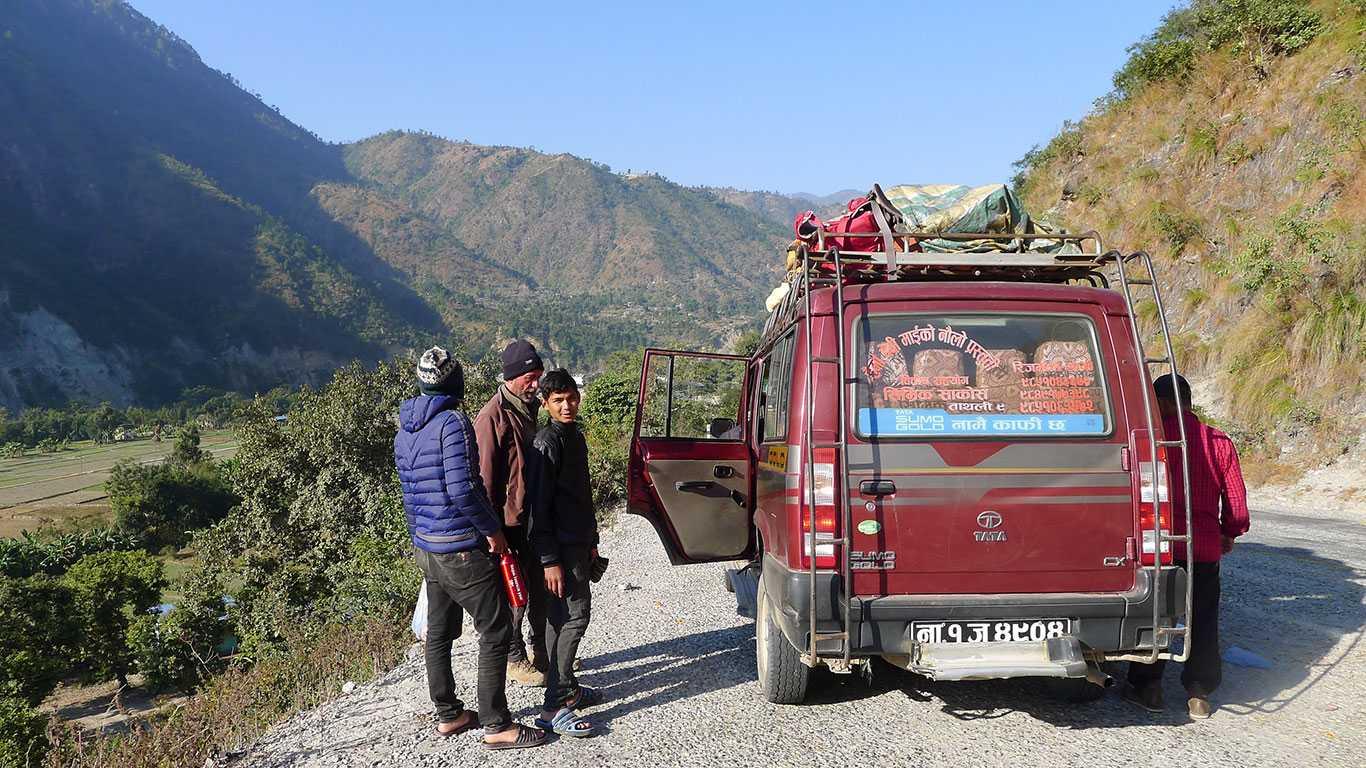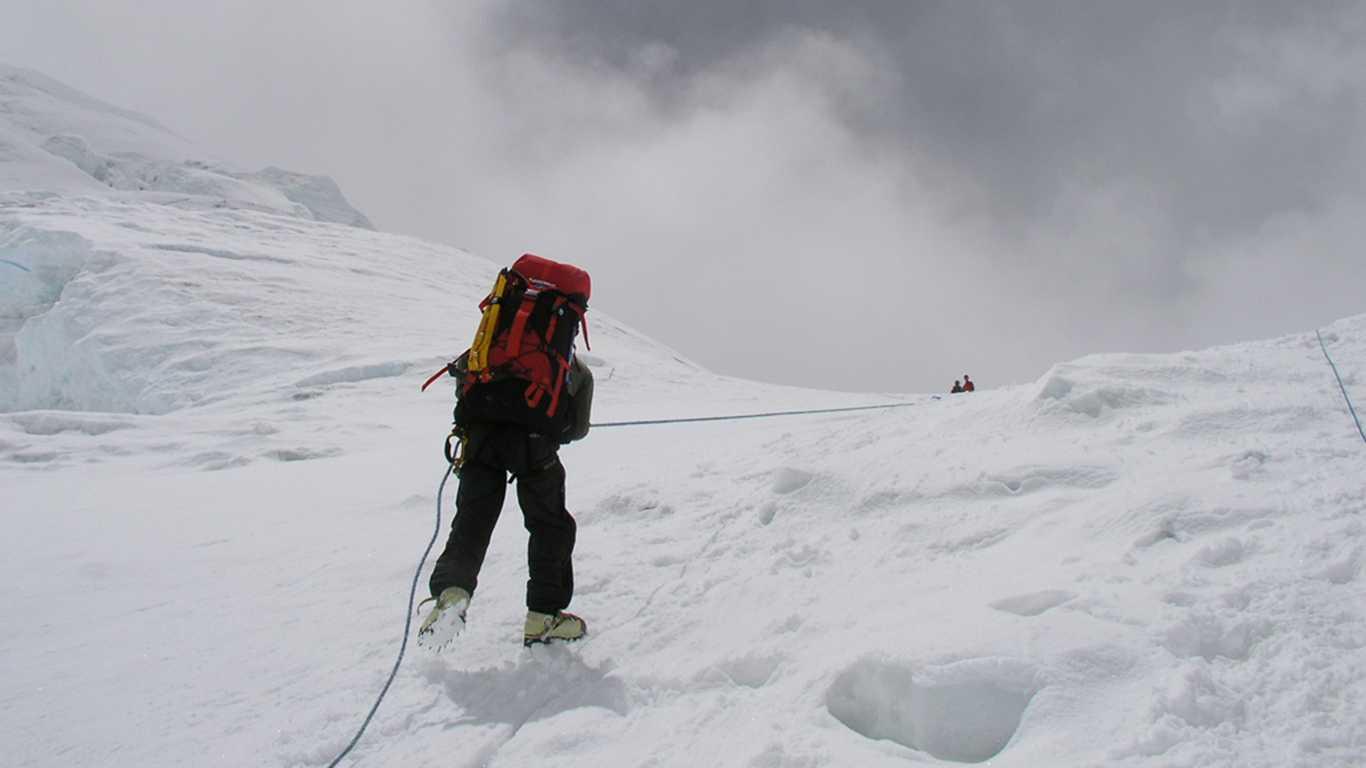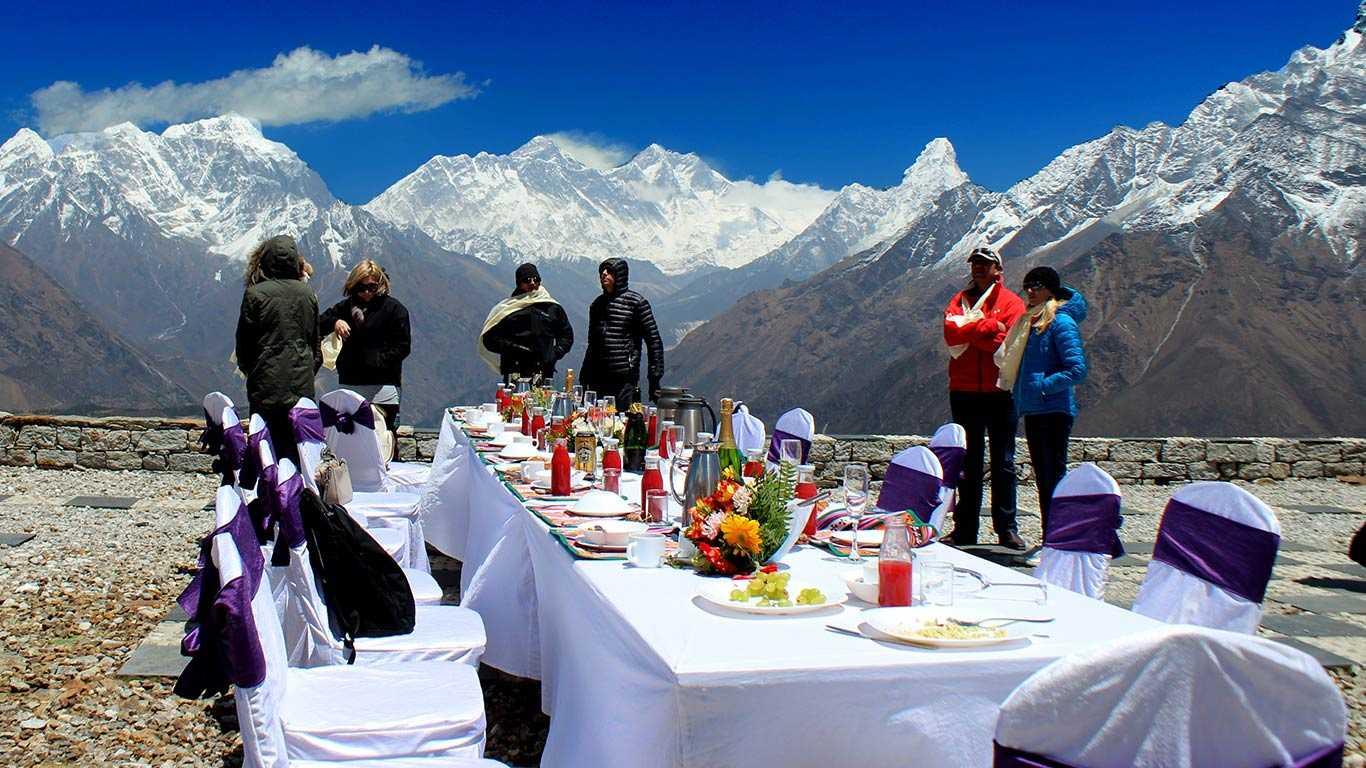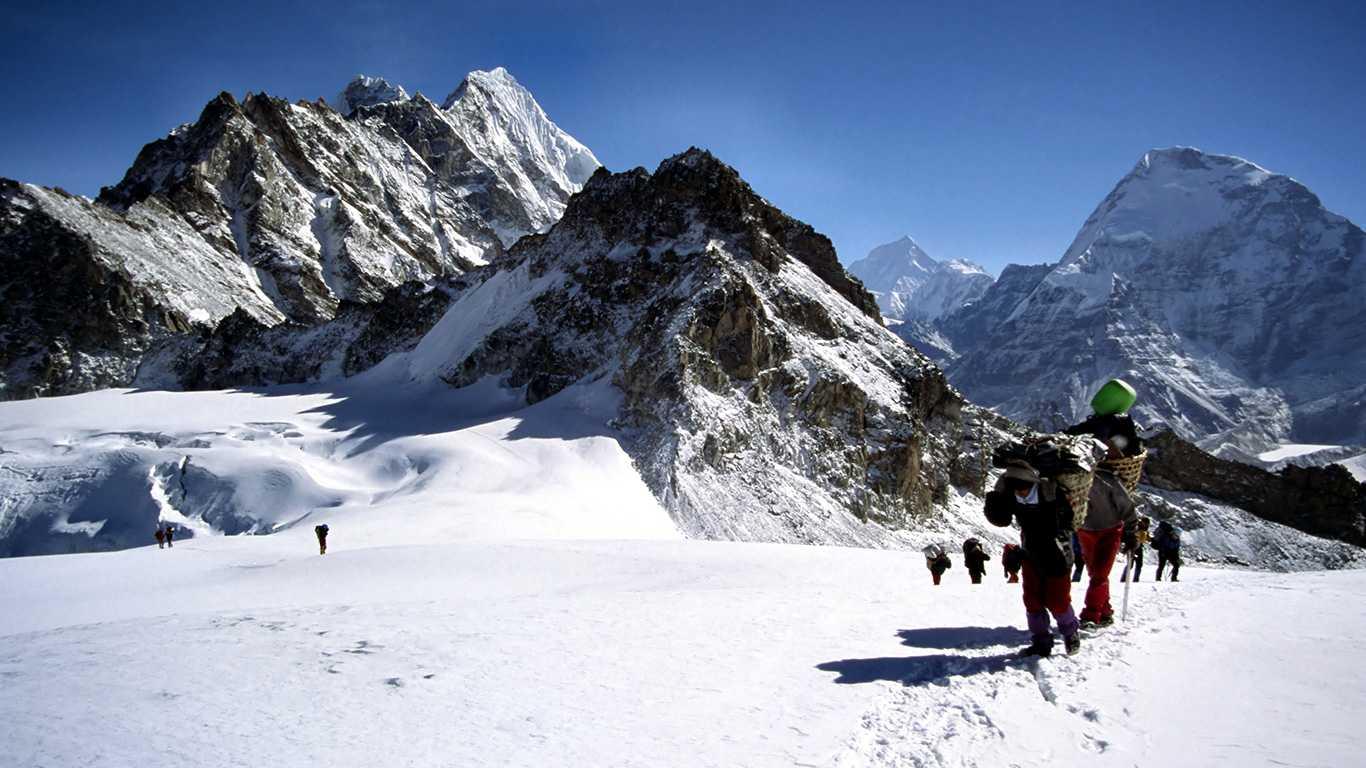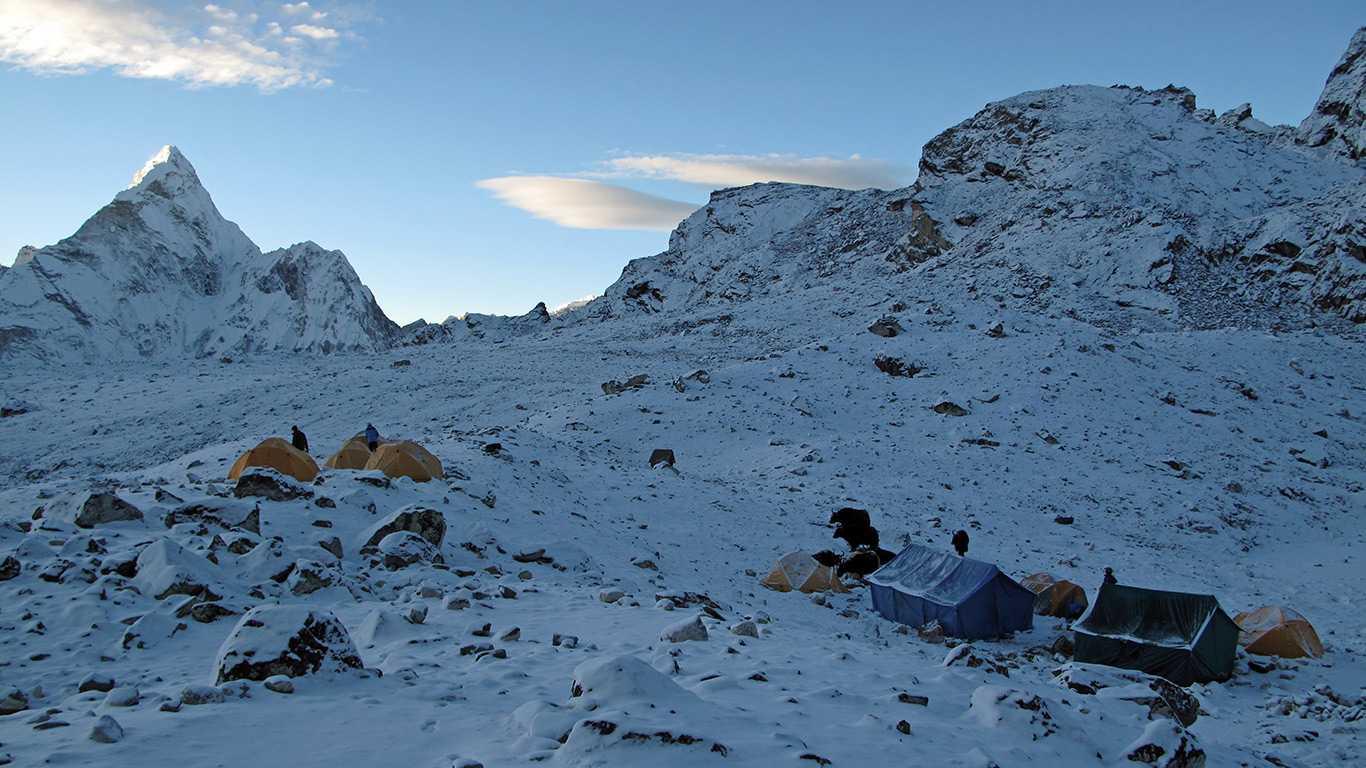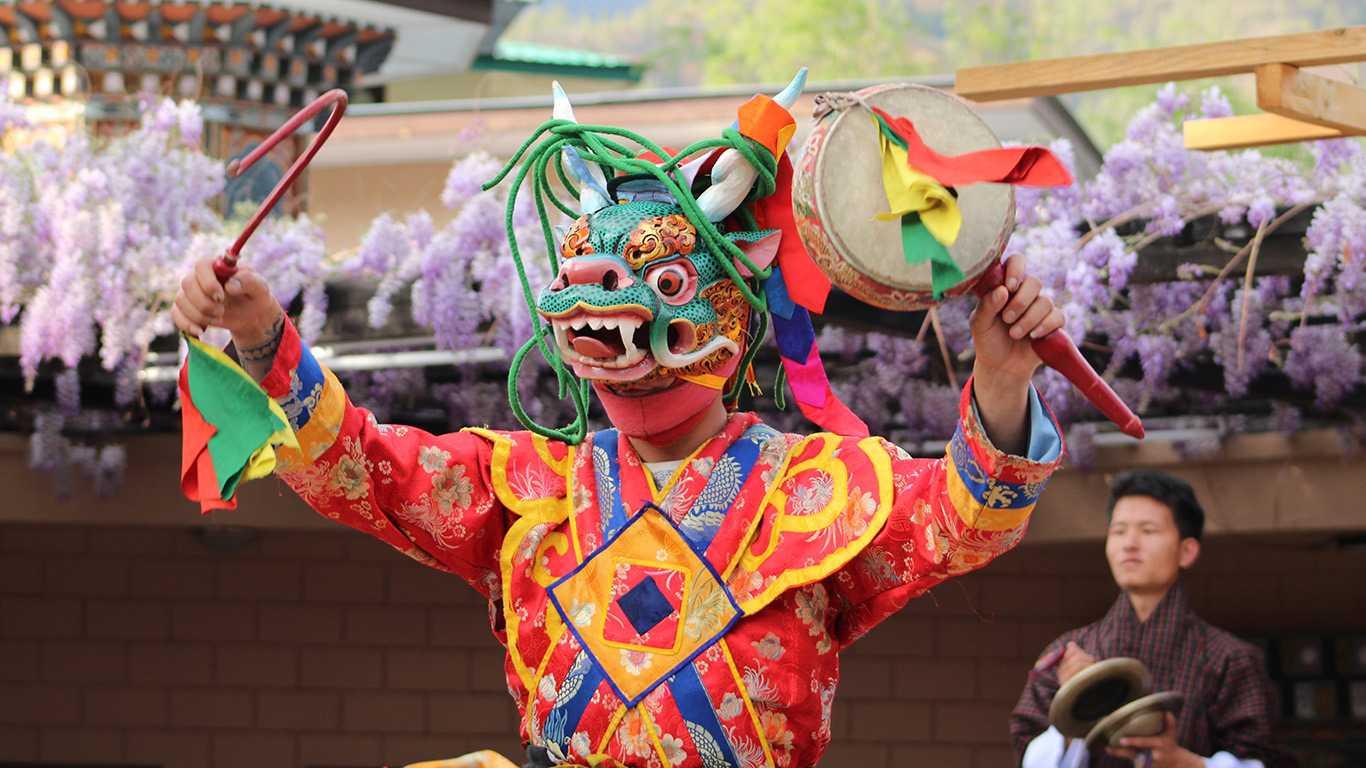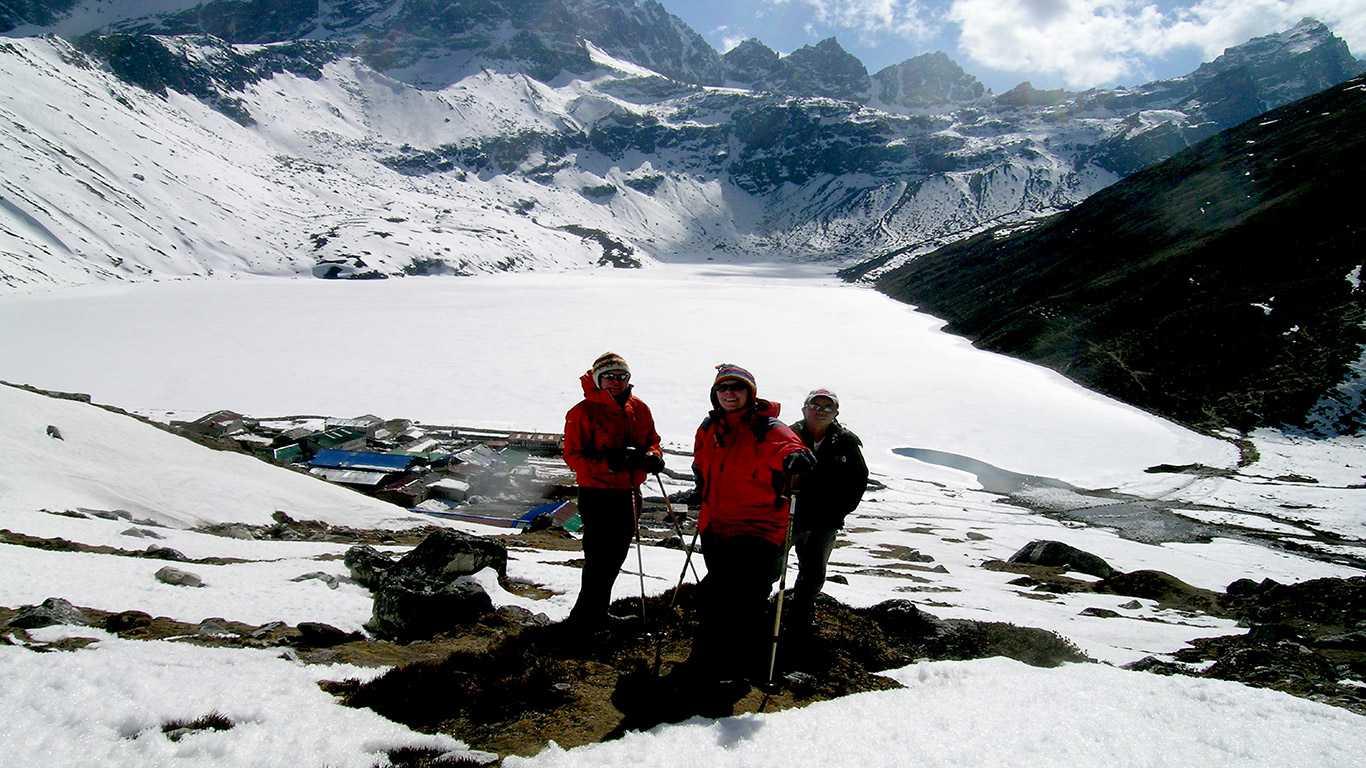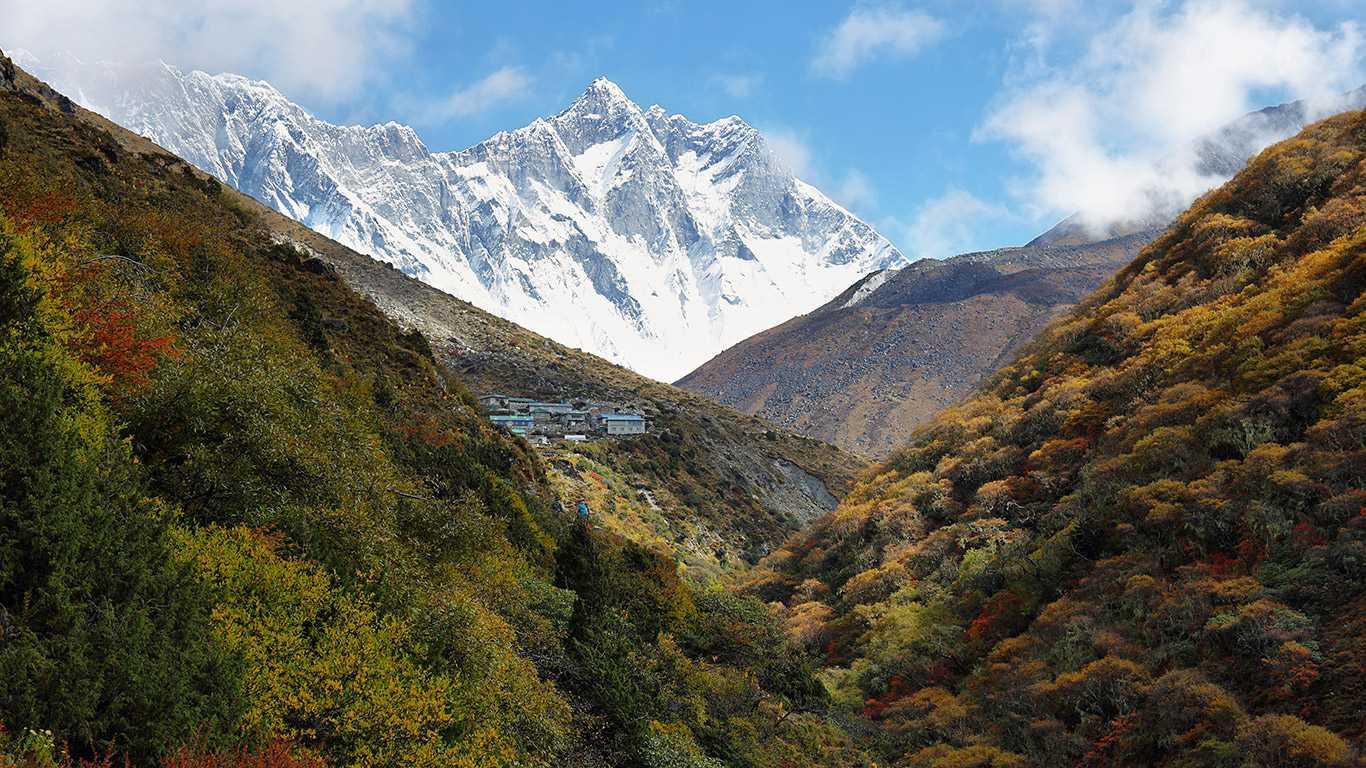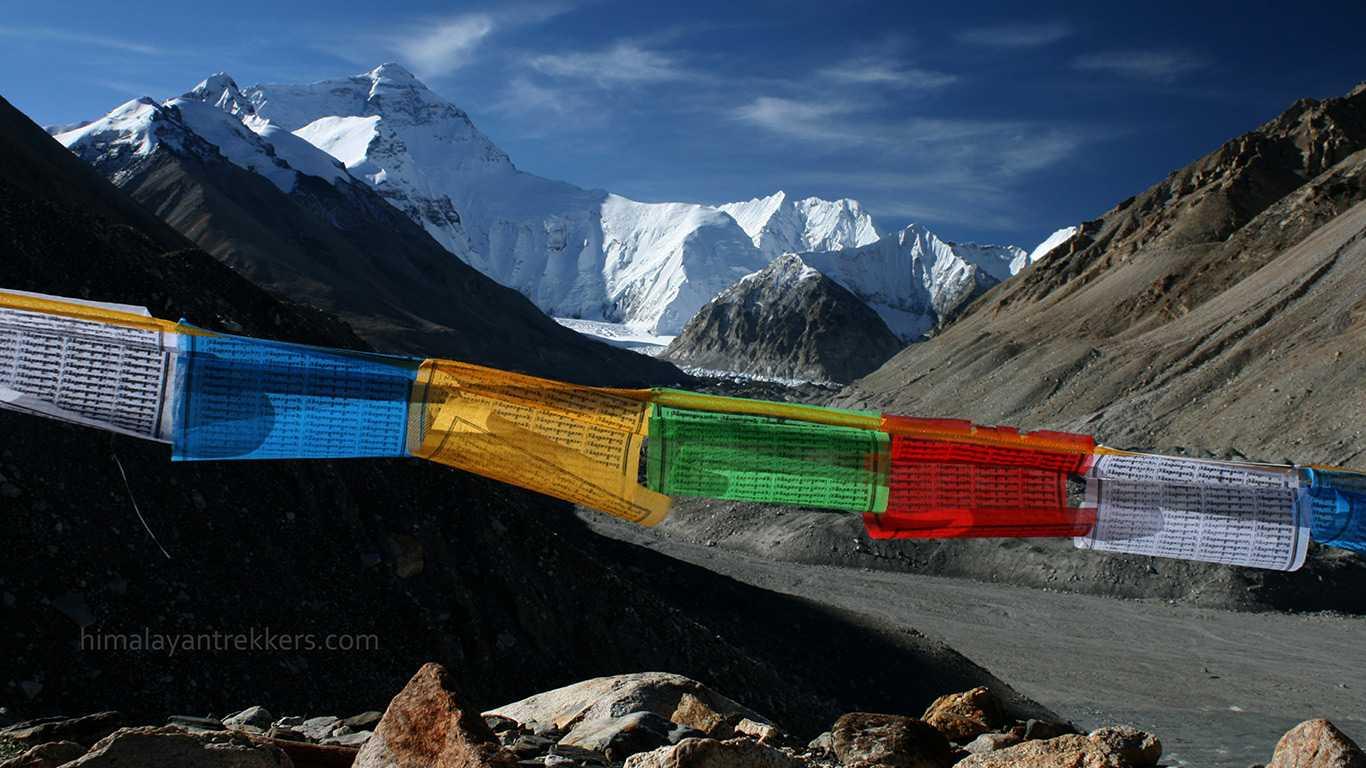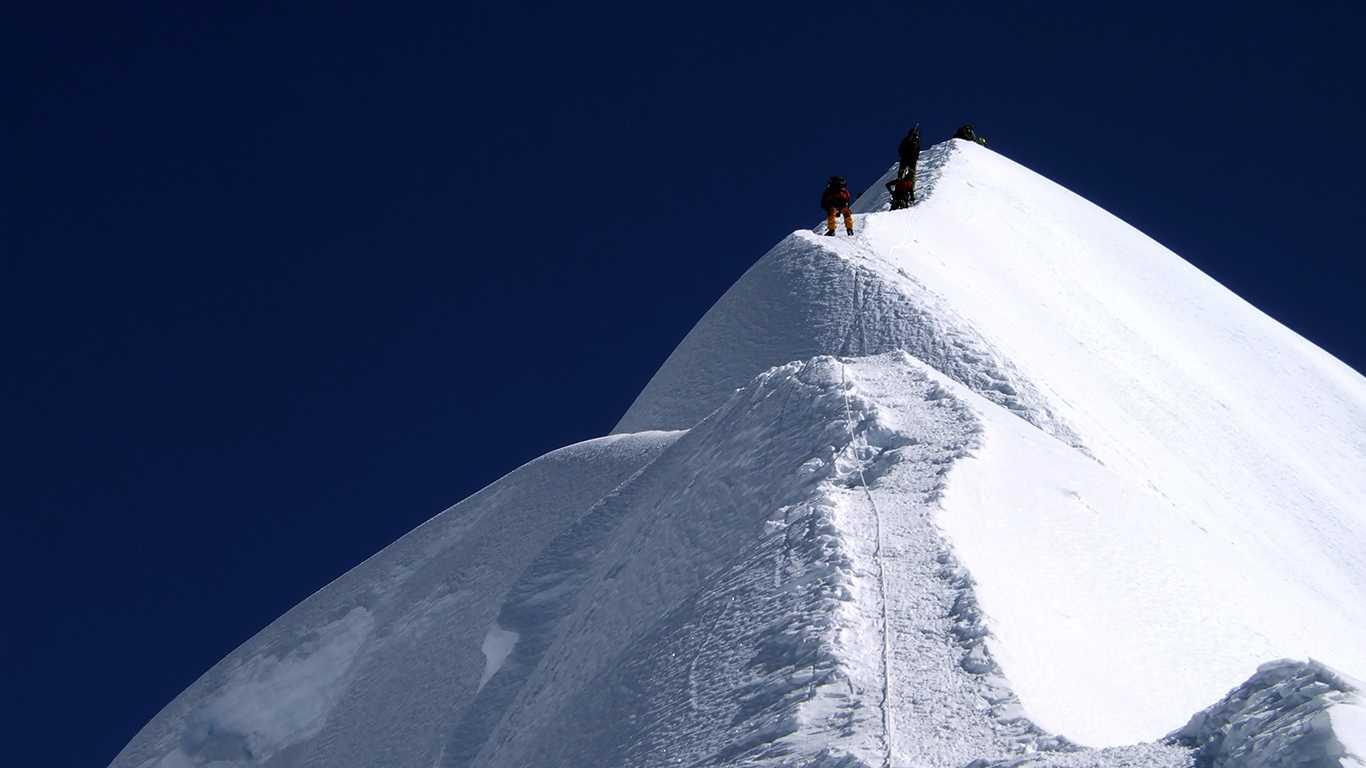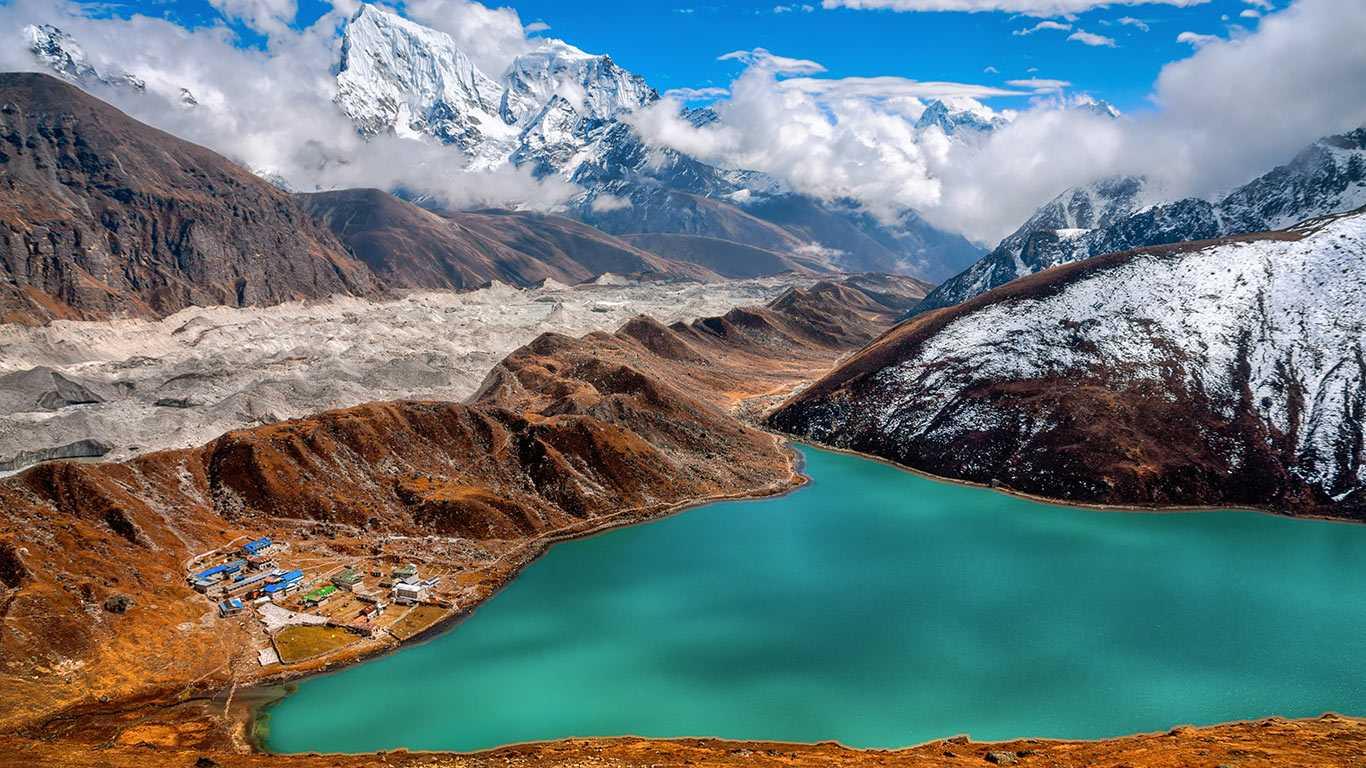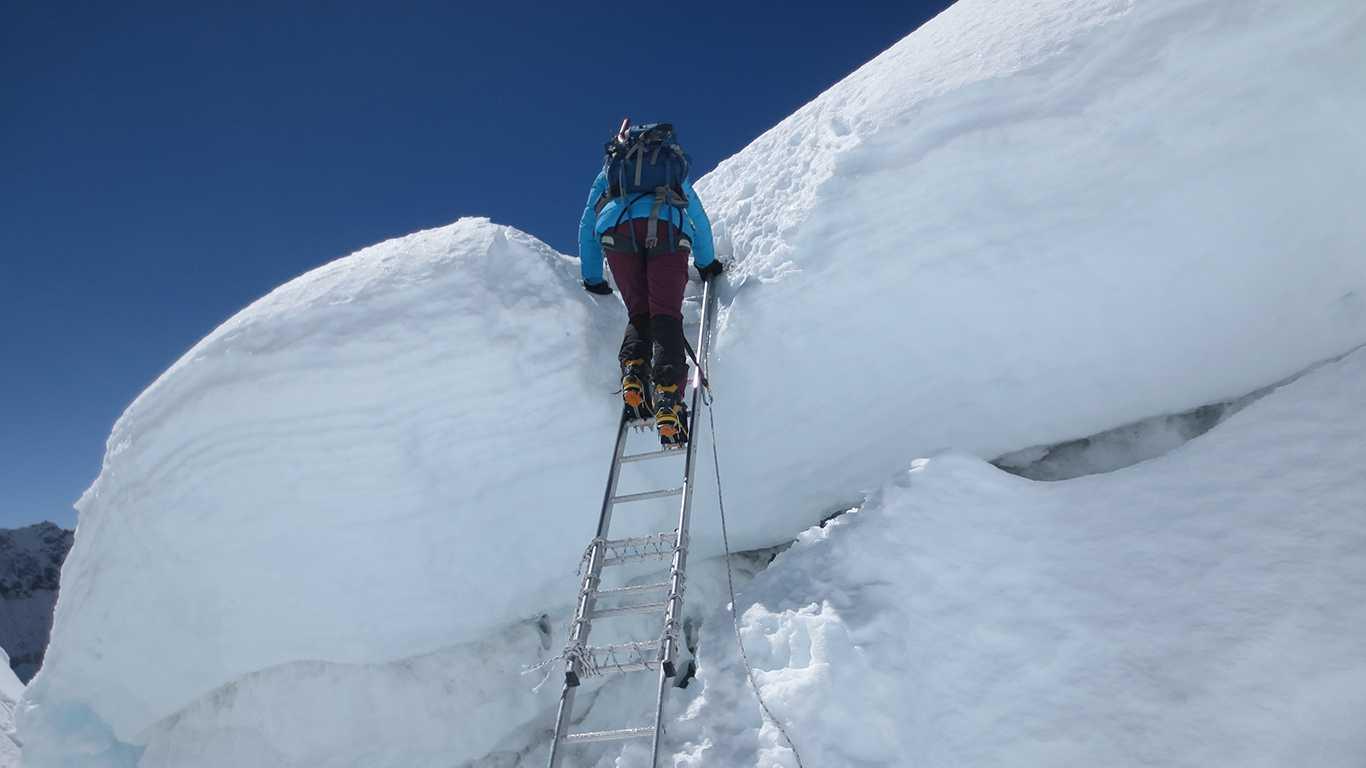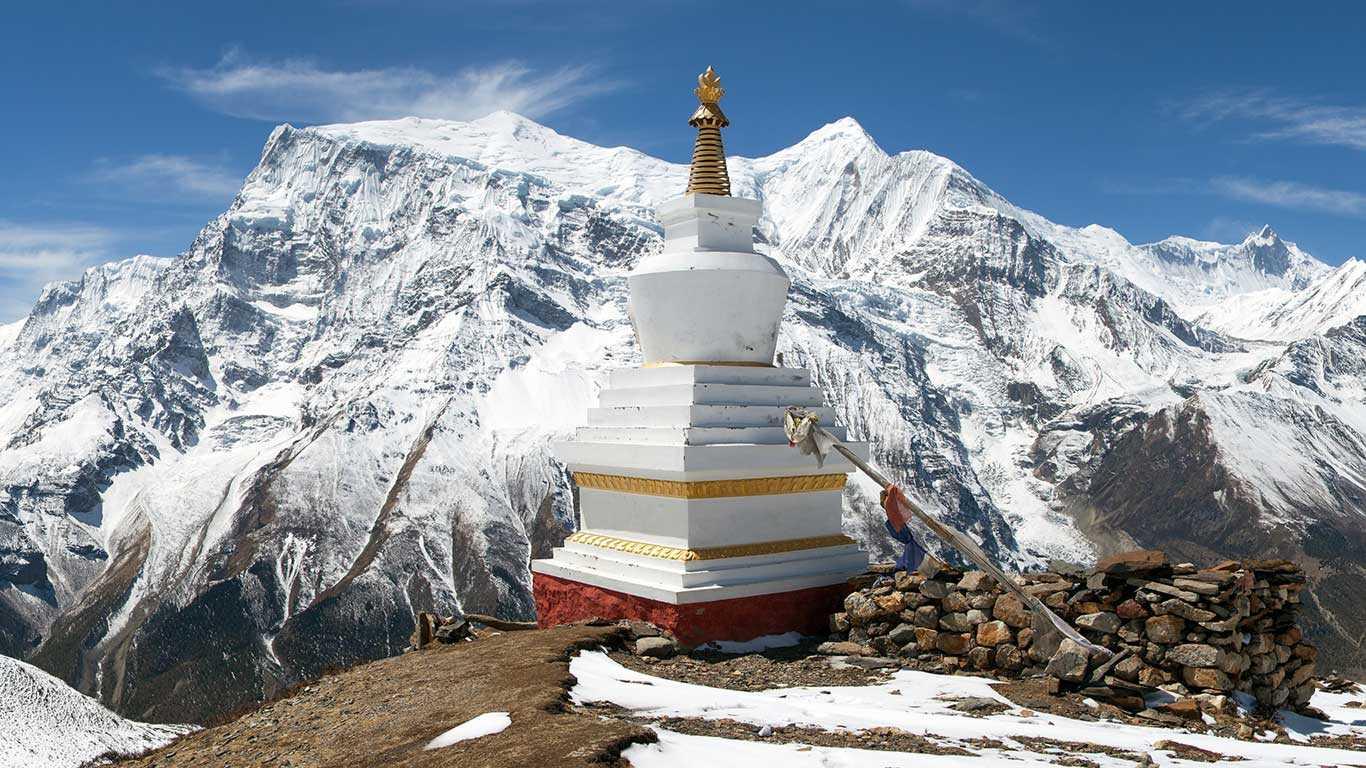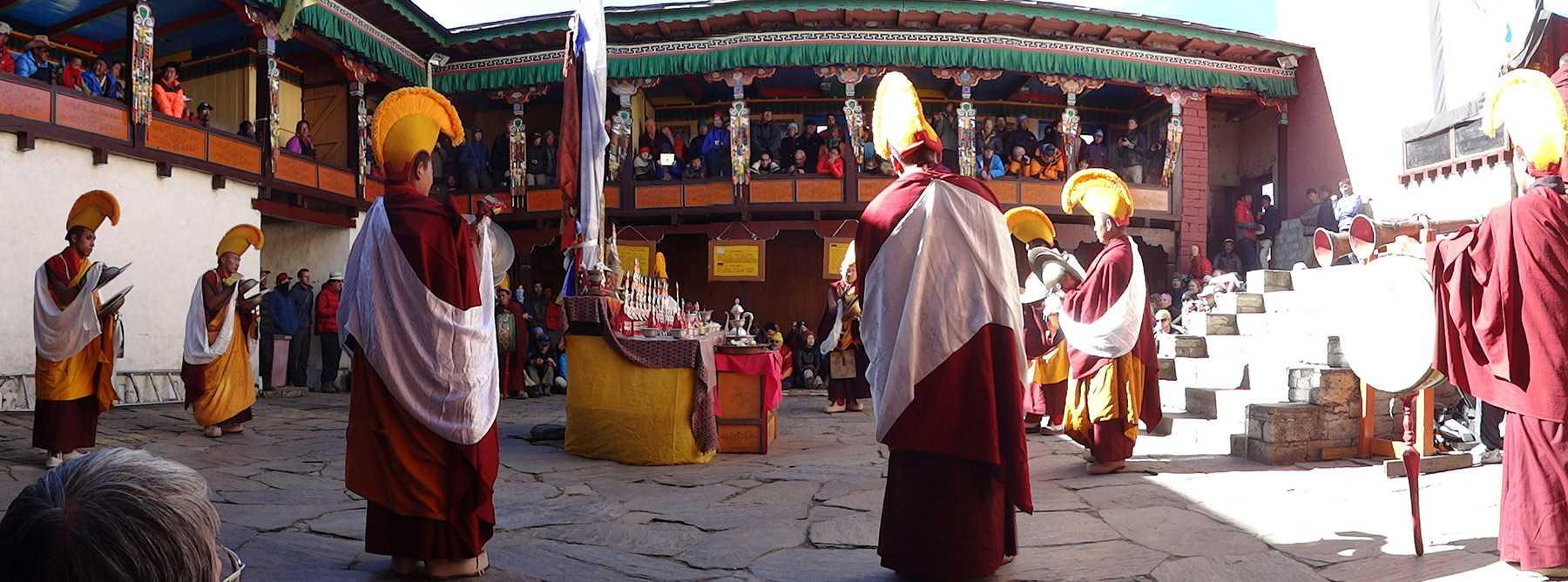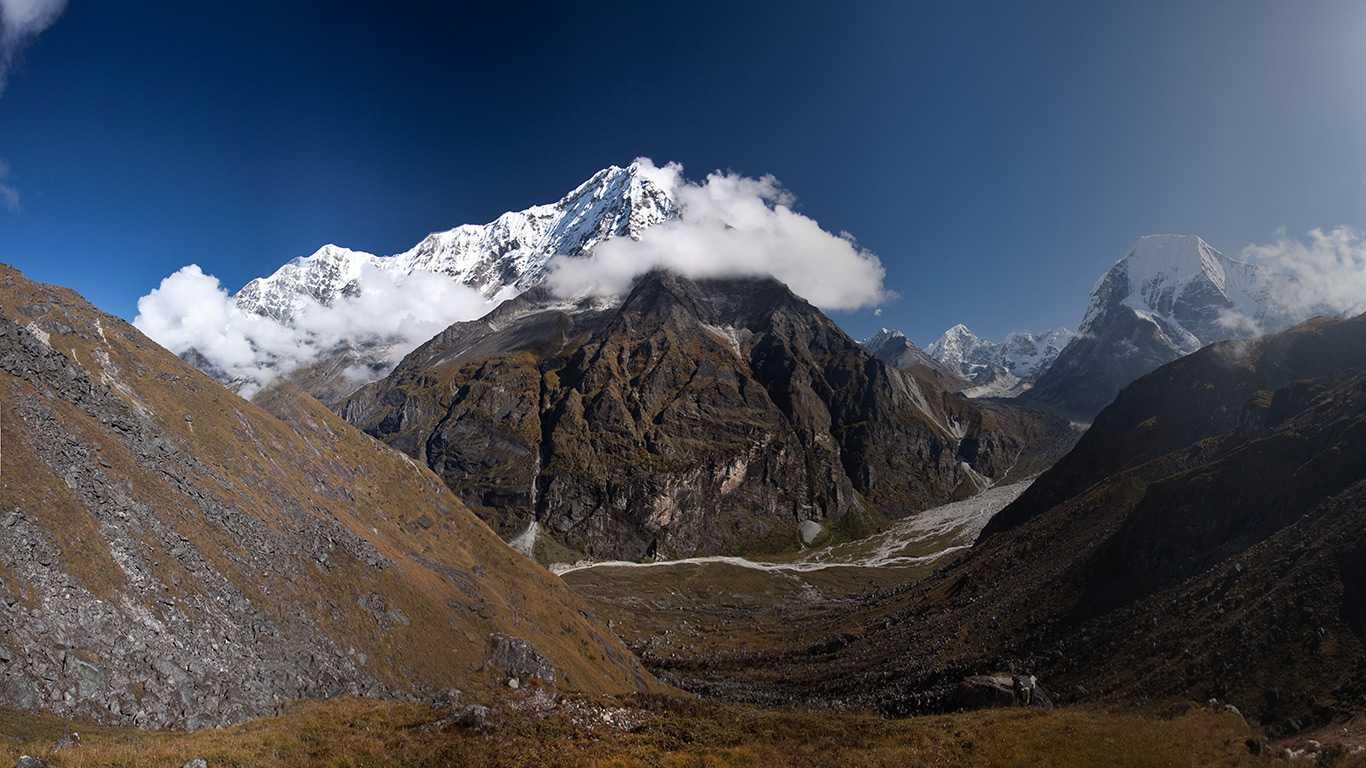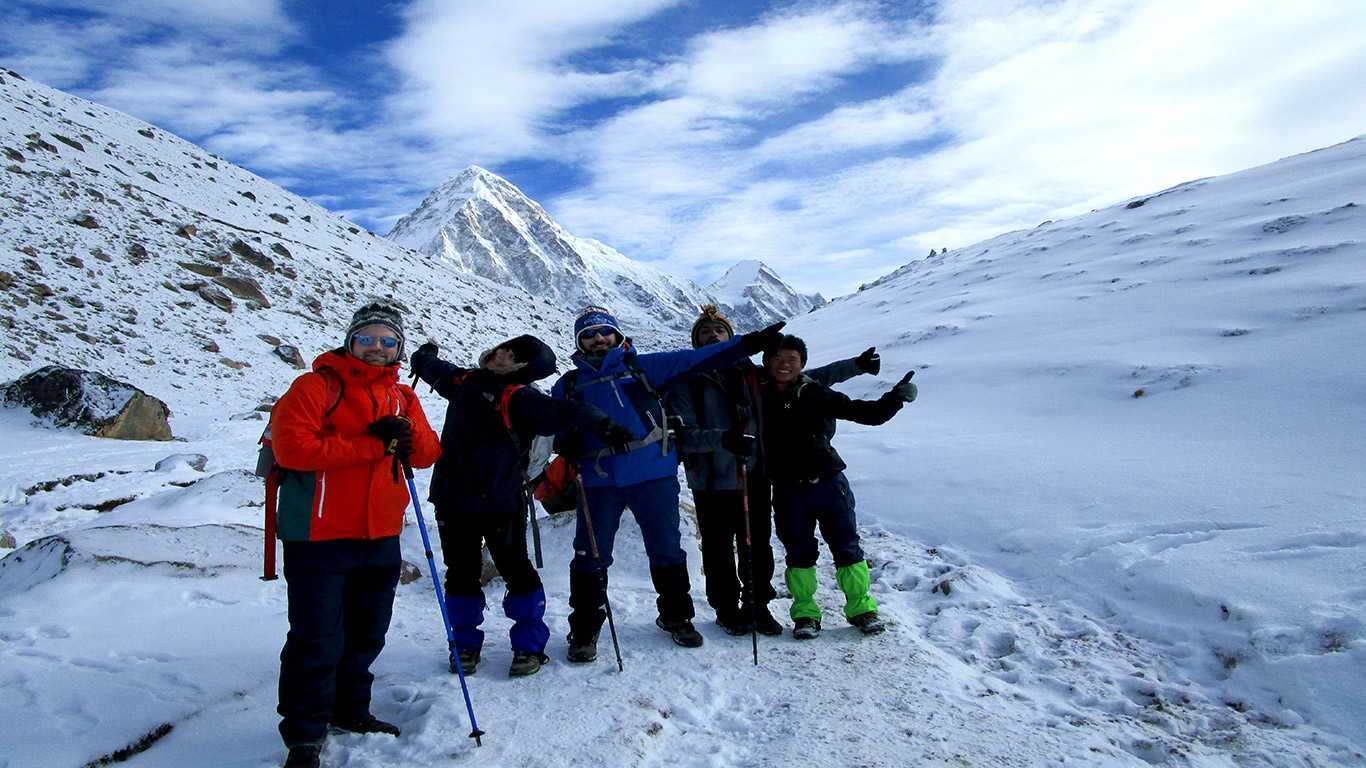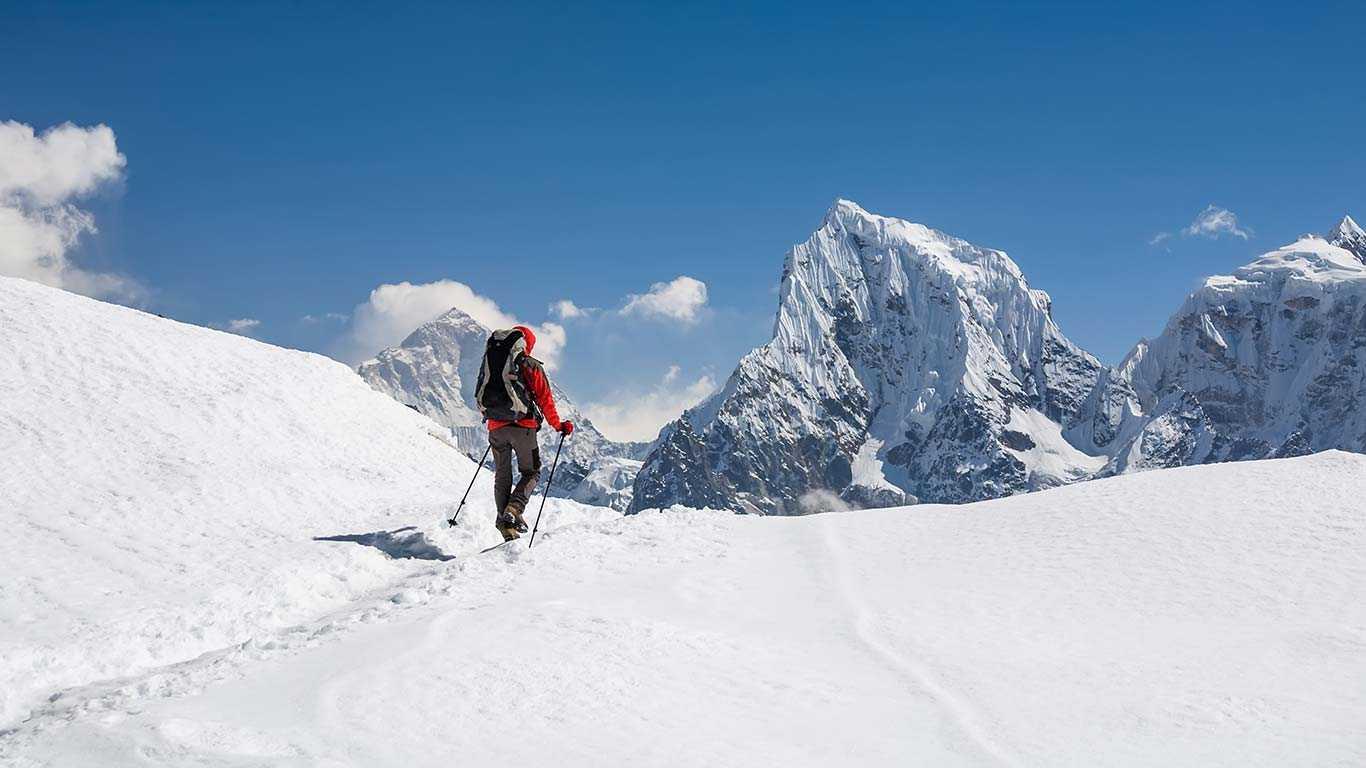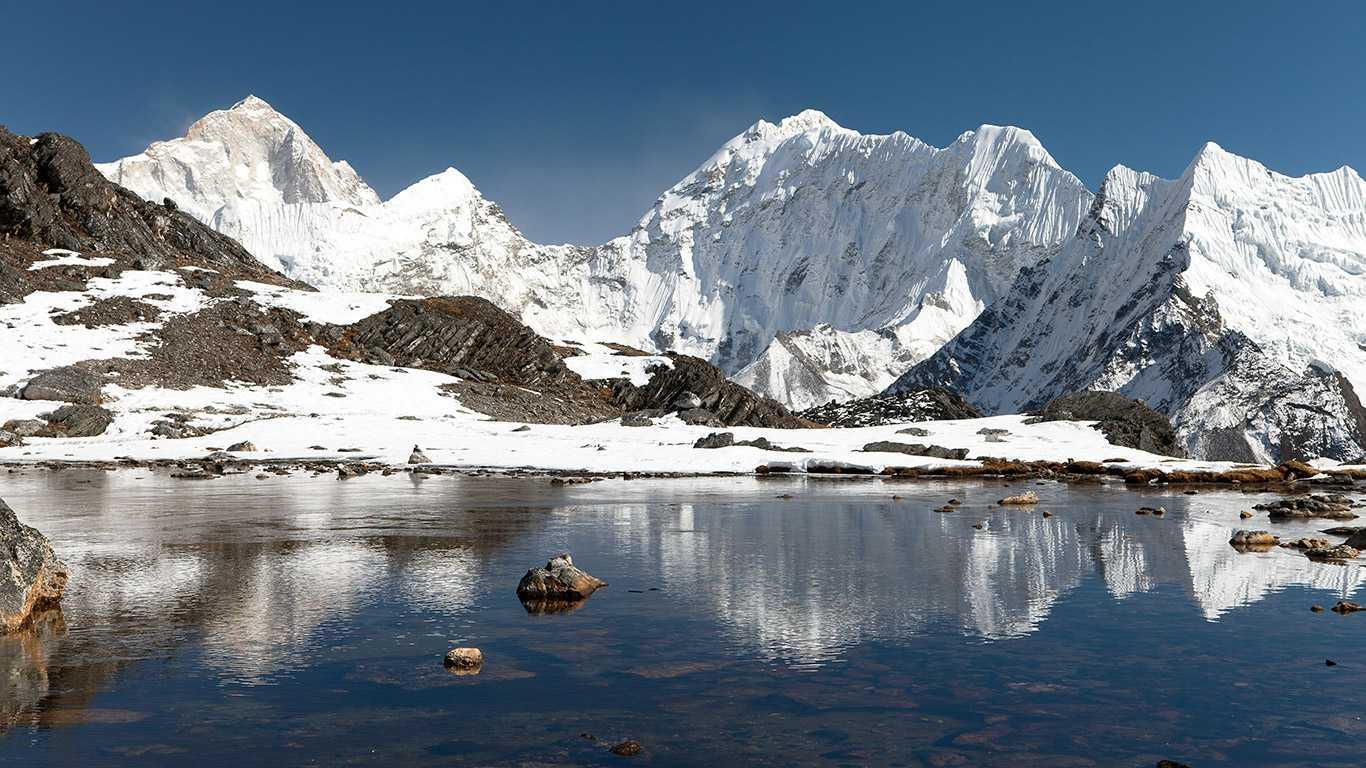
ENCOUNTER THE HIGHEST MOUNTAINS IN THE WORLD
The Khumbu Everest Base Camp (EBC) itinerary trek succinctly portrays the world's seven wonders, Mount Everest's highest mountain (8,848m /29,035ft). Among 14, 8000er mountains, 4 (Mount Everest, Mount Cho Oyu, Mount Makalu, and Mount Lhotse) are seen and can be visibly experienced. During the best season, under the clear and distinct blue sky, you can witness numerous amazing 6000 and 7000 above scenic mountain landscapes followed by Khumbu icefall, glaciers, lakes, panoramic landscapes, and passes.
The Everest Base Camp (EBC) Khumbu region warmly welcomes visitors, hikers, trekkers, and climbers with surreal experiences of unique Sherpa culture and monasteries, attractive flora and fauna, alpine rhododendron panoramic hills, and majestic mountain landscapes. While traveling to view the highest and largest mountain range, you engage in a thrilling and exciting mountain journey, witnessing verdant landscapes, conquering challenging itinerary trails, and accepting the awe-inspiring Himalaya experience of a lifetime.


HIGH PASSES AND HIDDEN VALLEY
The 80-mile (130km) breathtaking Everest Base Camp (5,364m/17,598ft) trekking duration is usually around 12-21 days. Depending upon your itinerary, the majestic Everest region, the EBC trip showers a variety of attractive destinations. As you begin and end your trek from the beautiful remote and majestic hidden valley in the Khumbu region, Lukla (2,860m) - the trekkers' junction point, along acclimatization on the classic and authentic Namche Bazaar (3,440m) village - the gateway of the Everest Base Camp (EBC) trek which accompanied you with a surreal breathtaking view.
The Everest Khumbu EBC trek's main highlighted destinations are Everest Base Camp, Kala Patthar, Gokyo Lake, and three high passes. During the best peak season trekking via Renjo La (5,360m) pass, Cho La (5,420m) pass, and Kongma La (5,535m) pass grants us a chance to experience many incredible panoramic mountains, unpredictable weather, iconic raw landscapes, scenic majestic Himalayan range, supportive guide, beautiful natural bond, and spectacular view in a clear and distinct sky.
Everest Region Trekking Packages packages
Everest, the crown of Nepal, rests in the Solukhumbu region. Moreover, the Khumbu region also falls in Solukhumbu. The Khumbu or Everest Region can be considered heaven for hikers and trekkers.
But did you know that it is the most visited region in Nepal? On average, the Sagarmatha National Park alone gets over 55,000 visitors annually. Most tourists come here to trek in the Sagarmatha National Park.
The term “Sagarmatha” is the Nepali dialect for Mount Everest. It means Head of the Sky. Sagar means sky, and Matha means head. And in Tibetan dialect, it's called “Qomolangma.” It’s also spelled “Chomolungma.” The meaning behind the name is “Goddess Mother of the World" or "Holy Mother.”
Where is the Everest region? The region is in the Northeastern part of Nepal. It’s in the Solukhumbu district. The elevation of the Everest region ranges from 2,860 meters to 8,848.86 meters.
The Everest region begins at Lukla. Its latitude is 27.6857° N, and its longitude is 86.7278° E. Similarly, the region ends at Mount Everest. Coordinates: latitude 27.9882° N and longitude 86.9254° E.
Why Trek in the Everest Region?
The Everest Region offers many treks close to each other. Its difficulty levels range from easy to hard.
This variety makes it a prime destination for all types of trekkers. Beginners to seasoned climbers enjoy treks in the Everest Region.
It's not just about summiting peaks. The region provides a deeply immersive experience. Trekkers can enjoy nature, culture, and ancient legends.
Treks pass through ancient Sherpa villages. Trek through fluttering prayer flags and icy Himalayan rivers.
You'll witness the first glimpse of Everest from Namche Bazaar. A moment that leaves trekkers in awe.
A further push brings you to the breathtaking sunrise at Kala Patthar. It is one of the best panoramic viewpoints of Everest.
Beyond the scenery, the journey introduces you to personal stories. These tales are shared in rustic tea houses.
You'll feel the spiritual pull of prayer wheels and centuries-old monasteries. These spiritual wells are across the Khumbu.
Trekking here is not just physical. You confront your limits at high altitude, gaining mental resilience.
The iconic Everest Base Camp trail or the quieter Gokyo Lakes route offer more than views.
Every step through the Everest Region becomes a transformational journey. It's where adventure meets the soul.
How to reach the Everest Region?
You can reach the Everest Region in two ways. Both ways need a bit of trekking to reach the region in question. The most common and fastest way is to take a flight from Kathmandu to Lukla. Or you can take the more scenic route, a road trip!
Option 1: Fly from Kathmandu to Lukla (Fastest & Most Popular)
Step 1: Go to Tribhuvan International Airport (Kathmandu)
· Domestic flights to Lukla depart from the domestic terminal.
· Arrive early, as weather delays are common.
Step 2: Board the flight to Tenzing-Hillary Airport (Lukla)
· Flight duration: 25–40 minutes
· Distance: 138 km / 86 miles
· Elevation gain: From 1,400 m (Kathmandu) to 2,846 m (Lukla)
· Tip: Sit on the left side of the plane for mountain views.
Step 3: Begin your trek from Lukla
· Lukla is the gateway to all major Everest Region treks (EBC, Gokyo, Island Peak, etc.).
· From here, your trekking adventure begins.
Option 2: Travel Overland by Road to Lukla (Via Salleri)
Step 1: Take a bus or jeep from Kathmandu to Salleri
· Daily services are available from early morning (5–6 AM).
· Travel time: 9–10 hours
· Distance: Approx. 265 km
· The road winds through scenic hills, rivers, and villages.
Step 2: Continue by road to Thamdanda
· From Salleri, local transport or private jeeps are available to Thamdanda, the road’s endpoint.
· Road conditions can vary; expect a bumpy ride.
· Travel time: Several hours, depending on season and weather.
3: Trek from Thamdanda to Lukla
· Trek duration: 2 days on average (via Surke)
· You’ll pass through small Sherpa villages and subtropical forest.
Total Time (Road Route):
· 3 days to reach Lukla (Kathmandu – Salleri – Thamdanda – Lukla)
· Total distance covered: Approx. 367 km
Price Comparison Road Trip Versus Flight:
Flights are the more expensive option of the two. A one-way ticket costs around 215 to 255 USD. Likewise, two-way tickets can range from $450-$480 per person.
Note: prices vary depending on the airlines.
Travellers can take a bus or a shared jeep for $25 per person to reach Thamdanda. From Thamdanda to Surke is a bit more expensive. You can take a shared jeep for $50 to $70 per person.
Note: can be higher during peak season or festivals.
Culture and community in the Everest Region
The Khumbu, or the Everest region, holds more than just mountains. It’s a place with thriving culture, tradition, and resilience. The Everest region is home to Sherpas and mountain people of various ethnicities.
People here are known for their mountaineering legacy. They also have warm hospitality, spiritual depth, and a deep connection with the land. The different ethnic groups live in harmony. Sherpas, Rai, Limbu, Tamang, Brahmins, and Chhetri live in harmony.
The trails in the Everest region are rich with cultural symbols. Many people in the Khumbu follow Tibetan Buddhism. Many paths are filled with prayer flags, mani walls, and ancient monasteries. One of the famous monasteries is Tengboche monastery. It offers spiritual refuge and panoramic Himalayan views.
The trekkers can witness traditional rituals, hymns, and festivals in the Everest region. Rituals, festivals, and lifestyles have remained unchanged for centuries. People still live in their stone houses in high-altitude villages.
Communities thrive against the harsh altitude and isolation. Despite the hard conditions faced by the locals, they are warm and welcoming. The tea houses and lodges in the Everest region offer hospitality like no other.
Varying Landscapes in the Everest Region
As the trail ascends, the landscape sees many shifts. It goes from green pine forest and rhododendron groves to stark, windy, and rocky moraines. Everest Base Camp is filled with glaciers and snow, unlike the forests found in Lukla.
The landscapes in the Everest region reflect life on the mountain. It houses a diverse culture and community, like varying topography. The Everest region is enduring, adaptive, and awe-inspiring. Every village has a story, and every mountain is sacred in the Everest region.
Popular Packages in the Everest Region
Everest Budget Helicopter Tour
It is an excellent package for your desire to see the Everest peak. Himalayan Trekkers offers you an affordable Helicopter tour. Here’s what you can expect from the package:
· Duration: 1 Day
· Max Altitude: 5,545 meters
· Coordinates: 28.0023° N, 86.8529° E
· Difficulty: Easy
· Trip Start: Kathmandu
· Trip End: Kathmandu
· Accommodation: Arrange accommodations for an extra charge
· Meals: Not Included
· Temperature: 15 °C Day
· Group Size: 3-5 People
· Best Season: Spring/Autumn/Winter
Thamserku Expedition
Thamserku offers a perfect view of snowcapped mountains. You can see Everest, Nuptse, Lhotse, Ama Dablam, and Cho Oyo. Expect these things on your Thamserku Expedition:
· Duration: 31 Days
· Max Altitude: 6,608 meters
· Coordinates: 27.79028°N 86.78750°E
· Difficulty: Hard Trek and Climb
· Trip Start: Kathmandu
· Trip End: Kathmandu
· Accommodation: 3-Star Hotels in Kathmandu, Lukla, and Namche. Tea houses and Tents during treks
· Meals: Breakfast, Meals during treks, “Welcome and Farewell” dinners are in the package.
· Temperature: 15 °C Day / -18 °C Night
· Group Size: 5-10 People
· Best Season: Spring/Autumn
Nuptse Expedition
Nuptse Expedition is among the hardest climbs in the Everest region. It is a challenging peak to conquer. You can observe the Khumbu Valley and the landscapes in the Everest region. Here’s what you should know about the Nuptse Expedition:
· Duration: 46 Days
· Max Altitude: 7,861meters
· Coordinates: 27.9664°N, 86.89°E
· Difficulty: Extreme Trek and Climb
· Trip Start: Kathmandu
· Trip End: Kathmandu
· Accommodation: 3-Star Hotels in Kathmandu, Lukla, and Namche. Tea houses and Tents during treks.
· Meals: Included with the package, with Welcome and Farewell Dinners in Kathmandu
· Temperature: 15 °C Day / -18 °C Night
· Group Size: 5-15 People
· Best Season: Spring/Autumn
Classic Everest Base Camp Trek
The classic Everest Base Camp trek is one of the most famous treks. And here are the highlights of the Everest Base Camp trek.
· Trek Duration: 21 Days
· Max Altitude: 5,545 meters
· Coordinates: 28.0023° N, 86.8529° E
· Difficulty: Moderate Treks
· Trip Start: Kathmandu
· Trip End: Kathmandu
· Accommodation: Tea house & Hotel
· Meals: Included in the package
· Temperature: 15 °C Day / -18 °C Night
· Group Size: 5-10 People
· Best Season: Spring/Autumn/Winter
Everest Base Camp By Road
The Everest Base Camp by road offers many things. It provides you ample time to enjoy the view, culture, and food. What should you expect from the Everest Base Camp by road? Here are the highlights of the trip:
· Trek Duration: 21 Days
· Max Altitude: 5,545 Meters
· Coordinates: 28.0023° N, 86.8529° E
· Difficulty: Moderate Treks
· Trip Start: Kathmandu
· Trip End: Kathmandu
· Accommodation: Standard Hotel in Kathmandu & Tea houses during treks.
· Meals: Included in the package
· Temperature: 15 °C Day / -10 °C Night
· Group Size: 2-16
· Best Season: Spring and Autumn
Pokalde Peak Climb Budget Service
Pokalde Peak offers a view of the world from a height of 5,806 meters. Moreover, it is among the most affordable treks in the Everest region. And here’s the highlight of the Pokalde Peak Climb:
· Trek Duration: 4 Days
· Max Altitude: 5,806 Meters
· Coordinates: 27.9250° N, 86.8333° E
· Difficulty: Moderate Treks
· Trip Start: Chhukung
· Trip End: Pokalde Peak Base Camp
· Accommodation: Installed Tent
· Meals: Included in the package (local menu)
· Temperature: 17 °C Day / -10 °C Night
· Group Size: Solo-16
· Best Season: Spring and Autumn
Everest Base Camp Budget Trek
Everest Base Camp budget trek offers the most bang for your buck. But we do not compromise on the services and facilities. Enjoy the same high-quality service.
· Trek Duration: 14 Days
· Max Altitude: 5,545 Meters
· Coordinates: 28.0023° N, 86.8529° E
· Difficulty: Moderate Treks
· Trip Start: Kathmandu
· Trip End: Kathmandu
· Accommodation: Standard Hotel in Kathmandu & Tea houses during treks
· Meals: Optional
· Temperature: 15 °C Day / -10 °C Night
· Group Size: 2-32
· Best Season: Spring and Autumn
Mera Peak Budget Climb
Mere Peak Budget Climb is solely based on climbing and trekking. We offer a four-day package. Find the highlights of the trip below:
· Trek Duration: 4 Days
· Max Altitude: 6,467 Meters
· Coordinates: 27.7090° N, 86.8678° E
· Difficulty: Intermediate Treks and Climbs
· Trip Start: Khare
· Trip End: Khare
· Accommodation: Tea houses and Tents
· Meals: Included in the package (local menu)
· Temperature: 20 °C Day /-10 °C Night
· Group Size: 1-15 People
· Best Season: Spring, Autumn, and Early Winter
Island Peak Climb Budget Service
Best pick for solo trekking and climbing on the list. We offer you an affordable four-day package. Highlights for Island Peak Climb:
· Trek Duration: 4 Days
· Max Altitude: 6,189 Meters
· Coordinates: 27.9747° N, 86.9248° E
· Difficulty: Hard Trek and Climb
· Trip Start: Chhukung
· Trip End: Chhukung
· Accommodation: Hotel at Chhukung & Tents during the trek
· Meals: Included in the package (local menu)
· Temperature: 15 °C Day /-15 °C Night
· Group Size: 1-16 People
· Best Season: Spring, Autumn, and Early Winter
Lobuche Peak Climb Budget Service
Lobuche Peak Budget Climb offers a 4-day trek at a very affordable price. Reach the peak of Lobuche East as a perfect adventure in the Everest Region. Highlights of the trek are:
· Trek Duration: 4 Days
· Max Altitude: 6,119 Meters
· Coordinates: 27.9595° N, 86.7899° E
· Difficulty: Moderate Treks
· Trip Start: Lobuche
· Trip End: Lobuche
· Accommodation: Tea house in Lobuche & Tents during the trek
· Meals: Included in the package (local menu)
· Temperature: 5 °C Day / -15 °C Night
· Group Size: 1-16 People
· Best Season: Spring & Autumn
Everest View Trek
If you want a panoramic view of the Himalayas, the Everest View Trek has it all. It offers a beautiful view of the famous peaks of the Everest region. Here’s what you can expect from the Everest View Trek!
· Trek Duration: 13 Days
· Max Altitude: Tengboche 3860
· Coordinates: 27.83361°N, 86.6999583°E
· Difficulty: Beginner-Friendly Treks
· Trip Start: Kathmandu
· Trip End: Kathmandu
· Accommodation: Hotels in Kathmandu & Tea houses during the Trek
· Meals: Included in the package
· Temperature: 5 °C Day / -10 °C Night
· Group Size: 1-10 People
· Best Season: Spring & Autumn
Everest region difficulty level
There are five difficulty levels in the Everest region. Moreover, some treks are very beginner-friendly. For one, the Everest View Trek and Pikey Peak Trek are prime examples.
Then, most other treks in the region can be considered moderate. Moreover, the trek to Everest Base Camp is a mild to low intermediate trek. Similarly, the Lobuche Peak trek offers stunning views of the Everest region.
Intermediate treks are a gateway to higher altitudes. Mera Peak is among the many intermediate treks in the Everest region. Most of the treks under this bracket require a good level of fitness. Clumber needs to have proper acclimatization to manage the altitude. They need to know basic mountaineering skills.
Before reaching the extreme climbs, Everest offers many hard treks. Island Peak climb falls under this category. In hard treks, climbers face high altitude, technical sections, and unpredictable weather. For seasoned mountaineers, Island Peak, Everest Three High Passes, and others are popular.
Lastly, the Everest region offers some of the most extreme climbs in the world. The Everest Expedition is the most extreme climb in the Everest region. Followed by the Lhotse Expedition. Trekkers combine multiple treks to challenge themselves. For example, some cross Mera Peak. Right after it, they trek to Amphu Laptsa Pass.
Beginner-Friendly Treks
· Everest View Trek
· Pikey Peak Trek
Moderate Treks
· Everest Base Camp
· Lobuche Peak trek
· Gokyo Lakes Trek
Intermediate Treks
· Mera Peak
· Renjo La Pass Trek
· Chhukung Valley Trek
Hard Treks
· Island Peak
· Everest Three High Passes
· Arun Valley to Everest Base Camp
Extreme Climbs
· Everest Expedition
· Island Peak + Everest Base Camp Combo
· Lhotse Expedition
Best Time to Be in the Everest Region: Seasons and Temperatures
Trekking in the Everest region has a small timeframe to make the most of it. True, you can visit Solukhumbu any time of the year. But the true beauty of the Himalayas is seen only in a select few seasons. First up: Spring!
Spring (March to May)
The Himalayas welcome Spring in March every year. During spring, the weather is mild, and the sky is clear. The view of Everest and the surrounding peaks opens. Spring lasts till May.
Aside from the weather, temperatures are welcoming at this time in the Khumbu region. Daytime typically doesn’t go below -5°C (23°F) or go above 10°C (50°F). Likewise, the night temperature can dip to -15°C (5°F).
Summer (June to August)
Summer in the Himalayas is from June to August. Due to the monsoon season, many of the trekking trails will be off-limits in the Summer. The lower areas of the Everest Region will be filled with greenery. Likewise, it is great for photography before the rain his in the morning.
Namche Bazaar has a mild temperature during summer. The temp stays around 15°C in the daytime. Moreover, during the night, the place dips to around 7°C. Moving a bit up to Gorakshep, it's 10°C during the day. At night, the area drops to 0°C.
Autumn (September to November)
Autumn, along with Spring, is a prime season for trekking in the Everest region. From September to November, the Khumbu region has the best visibility. It has dry and clear skies. Like spring, the weather is comfortable.
As for the temperature, Namche Bazaar sees 8–12°C during the day. At night, Namche sees a drop to 0–4°C. Gorakshep’s daytime temp drops to -4°C. Nighttime in Gorakshep is -12°C.
Winter (December to February)
December to February covers the Himalayan region with snow. The view of snow-covered landscapes is like candy for the eyes. However, high passes like Cho La and Kongma La remain closed due to the snow.
The nights become extremely cold during winter in the Everest region. Namche Bazaar experiences a daytime temperature of 4 Degrees Celsius. At night, the temp can reach -6°C. In Gorakshep, temperatures can drop to -8°C during the day and -18°C at night.
Accommodation and Food
Most of our packages include accommodation and meals. We select only the hotels and tea houses that meet our standards. The accommodation will be hygienic and comfortable. In Kathmandu, we pick the best hotels that meet the criteria.
Meals will be included in the package. Kathmandu offers a wide selection of cuisine. Your lunches and dinners will have vast options. Likewise, you can choose from a catalogue of desserts and drinks.
Accommodations and meal choices become fewer during the treks. Most places to rest in the Everest region are tea houses. Similarly, the menu becomes more limited the higher we go. But you can handpick delicious and wholesome meals from the region.
Accommodation and Facilities in the Everest Region
Here’s what to expect from the type of accommodation in the Everest Region!
Tea houses:
Tea houses are the most common form of accommodation in the Everest region. Local families run these places. Tea houses offer basic shelter, home-cooked meals, and an authentic Sherpa welcome.
Rooms: Simple twin beds. Has shared toilets and wooden walls.
Dining: Warm dining halls with a yak-dung stove in the middle.
Food: Dal Bhat, momo, noodle soup, pancakes, and tea.
Facilities: Cold/hot showers cost extra, limited charging, and Wi-Fi.
Where: Tea houses are in nearly every village from Lukla to Gorakshep.
Hotels:
In cities and most villages, you can choose which hotels to stay in. While not common in higher altitudes, you can find hotels in Lukla and Namche Bazaar. Here is what you can expect from hotels in the Everest Region.
Rooms: Private bathrooms, comfortable bedding, and heating options.
Services: Hot showers, laundry, charging stations, and restaurants.
Food: Local and international menu. It includes vegetarian and vegan options.
Where: All over Kathmandu. Few in Lukla, Phakding, Namche, and Dingboche.
Trek Lodges:
Trek lodges are the best of both worlds. You can get the charm of tea houses and the amenities of a hotel. Moreover, they are the most luxurious on our list. Here is what you can expect from your stay at a trek lodge.
Rooms: Clean, en-suite bathrooms. Thicker mattresses and often solar-heated.
Dining: Set menus, some offer espresso and baked goods.
Facilities: Reliable charging, Wi-Fi, and some have oxygen and health stations.
Where: Operated by brands like Yeti Mountain Home and Everest Summit Lodge. They are in Lukla, Phakding, Monjo, Namche, and Pangboche.
Foods that are only found in the Everest Region: A Taste of the Himalayas
The Everest region isn’t just rich in mountains. Khumbu has Sherpa Flavors, fermented traditions, and hearty dishes. Every dish is designed for a high-elevation lifestyle. Their food is rooted in Buddhist culture, local ingredients, and survival wisdom.
Unique Foods
Rildhuk – Sherpa Potato Porridge:
A thick, hearty dish made by pounding boiled potatoes. They are cooked with herbs, salt, and sometimes Yak fat.
Where to find: Family homes, a few local restaurants.
Why It’s Special: Rarely served in restaurants. Deeply local and sustaining in the cold.
Shyakpa – Sherpa Stew:
A noodle stew with radishes, carrots, potatoes, garlic, and pieces of meat. Usually, yak or mutton is used while making Shyakpa. It is served in most restaurants.
Flavour: Mild, herbal, and wholesome.
Phapar ko Roti – Buckwheat Pancake
A nutty, slightly bitter pancake made from buckwheat flour grown at high altitudes. It’s often served with yak butter, chili chutney, or honey.
Local pairing: Great with Tibetan tea or raksi (millet alcohol)
Tsampa – Roasted Barley Flour
Mixed with butter tea or water to form an energy-rich dough ball.
Traditional use: Offered in rituals and eaten during pilgrimages
Spiritual connection: Integral to Sherpa Buddhist customs
Yak Cheese and Yak Meat Dishes:
Yak cheese is creamy, strong, and nutrient-dense. It's perfect for high-altitude trekking. Dried yak meat (Sukuti) is often stir-fried with chili and garlic.
Where to find: Local lodges in Namche, Thame, or Pangboche
Unique drinks
Butter Tea (Su Chya) – Salted Yak Butter Tea
Made from black tea, salt, and yak butter. The tea is thick, salty, and calorie-rich.
Purpose: Keeps your body warm and hydrated at altitude
Acquired taste: Try it at monasteries or tea houses
Tingmo with Tibetan Tea – Steamed Fluffy Bread & Tea Combo
Tingmo (steamed fluffy bread) is often served with butter tea in Sherpa households
Where to try: Monasteries or local tea houses and restaurants
Chyang / Raksi – Homemade Millet or Barley Alcohol
Sherpa families brew local alcohol for celebrations and rituals.
Raksi: Distilled and potent
Chyang: Fermented, cloudy, and milder
Seabuckthorn Juice
This orange Himalayan berry grows in the lower Khumbu (like around Lukla). It is packed with vitamin C.
Taste: Tart, citrusy, and refreshing
Available at: Select eco-lodges and tea shops in Namche or Phakding
What Permits Are Required for Trekking in the Everest Region?
As you may already know, permits are required to trek in the Everest Region. But you can easily get them in Kathmandu, Lukla, or Monjo. We acquire these permits by the time you lace up your boots for the Everest region.
Permits Required for Trekking in the Everest Region:
Khumbu Pasang Lhamu Rural Municipality Permit:
Required for: All trekkers entering the Khumbu (Everest) Region.
Where to Get it and Cost:
Get it in person at Lukla, Monjo, or the Tourism Board office in Kathmandu
Cost: NPR 2,000 (approx. $20) per person for the first 4 weeks
NPR 2,500 if staying beyond 4 weeks
Note: This has replaced the former “TIMS card” for the Everest Region.
Sagarmatha National Park Entry Permit:
Required for: All trekkers entering Sagarmatha National Park. It includes the Everest Base Camp and Gokyo routes.
Where to Get it and Cost:
Nepal Tourism Board office in Kathmandu or at Monjo (park gate).
Cost: NPR 3,000 (approx. $25) per person, 13% VAT applies (total = ~NPR 3,390)
Gaurishankar Conservation Area Permit (only if trekking via Jiri or Salleri)
Required for:
Trekkers on the road route through Jiri, Bhandar, or Salleri before reaching Phakding.
Where to Get it and Cost:
Nepal Tourism Board, Kathmandu
Cost: NPR 2,000 per person
Note: Not required if flying into Lukla.
Climbing Permits (if doing peaks like Island, Mera, Lobuche, Pokalde)
Issued by: Nepal Mountaineering Association (NMA)
Cost (varies by season and peak):
· Island Peak: $250–$500
· Mera Peak: $250–$500
· Lobuche Peak: $250–$500
· Pokalde Peak: $70–$175
Additional requirement:
A licensed climbing guide is mandatory
The insurance and expedition itinerary must be submitted
What to Bring for Permit Issuance
· 2 passport-sized photos
· Copy of your passport
· Cash (Nepali Rupees) — most checkpoints don’t accept cards








